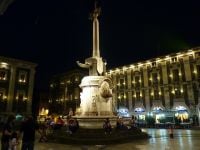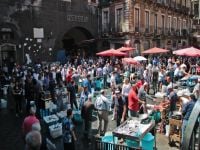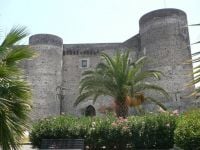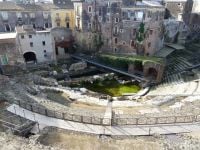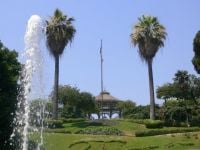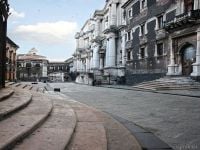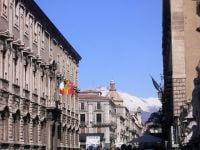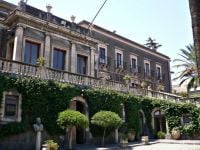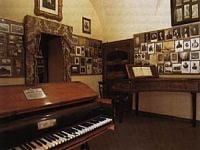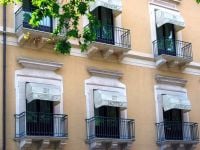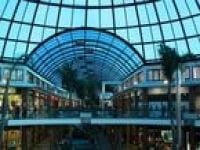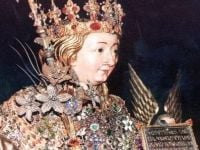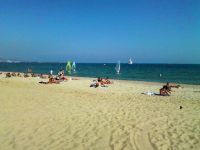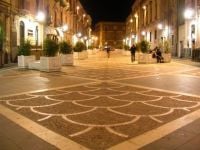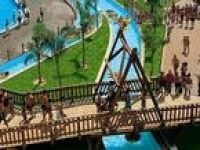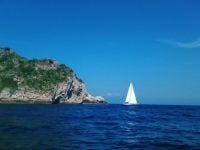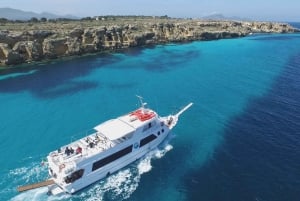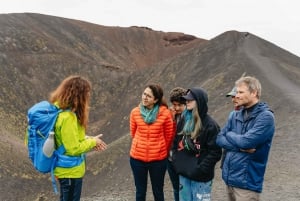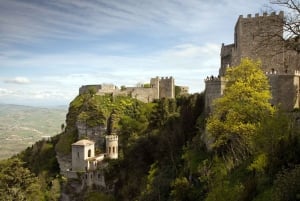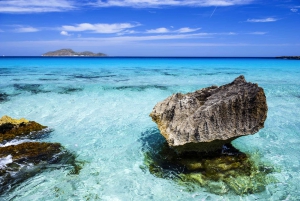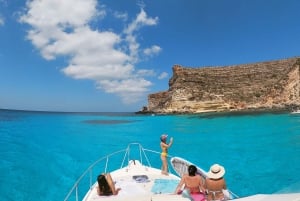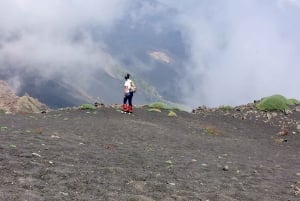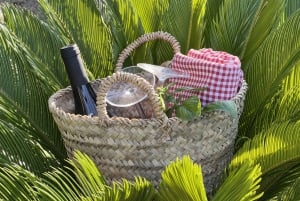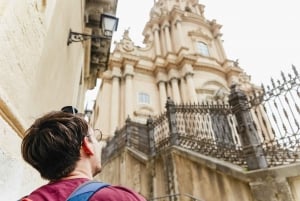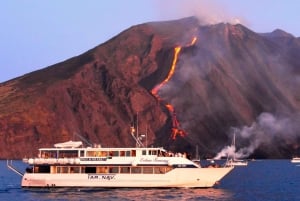Catania
Dark Daughter of Mount Etna
Catania lies under the shadow of Mount Etna on the Ionian Sea in a huge plain with endless lemon and orange plantations â Sicilyâs main cultivating area for citrus fruits. In 1669 there were tremendous eruptions for about four months, and an enormous lava flow buried almost the entire city. What was left of Catania was destroyed by the devastating earthquake of 1693. As you can see today, the Catanese city dwellers were practical people: instead of transporting stones from far away quarries, they took what was lying around and used lava as main building material. Cataniaâs Baroque town centre is dark grey and unique in the world for this. The city was rebuilt with wide avenues and large open squares. You wonât find a maze of winding alleys like in Palermo or the old town centre of Syracuse, Ortygia. The Catanesi were not only practical but also tough. Several times earthquakes and volcanic eruptions destroyed and damaged Catania and killed many inhabitants. Its successive populations were deported by one Greek tyrant, enslaved and sold by another, then driven out by the Carthaginians. In the Middle Ages many people died from the plague. The Catanesi always got back on their feet and rebuilt their town again and again.
Nowadays the city remains still full of traffic, but Piazza del Duomo and parts of the main road Via Etnea are now pedestrian zones and the restoration of many of the historic buildings add to the charm. You may ask yourself now: âDoesnât it look a bit dull, if everything is dark grey and black?â No, it definitely does't. Home to a big university, Catania is full of young people and over boarding life, what shows in the numerous boutiques, shops, designer bistros, bars, restaurants and chic wine taverns. And Catania's historical centre has been declared UNESCO World Heritage Site meaning that money is coming in. The city has a vibrant cultural life and is supposed to be one of the liveliest town of Southern Italy, charming, unique, a city of contrasts - traditional and modern life in a historical backdrop.
Catania is unfortunately still ignored by many Sicily visitors. Most of them arrive at the airport and head immediately to their further destination. We find this very sad and recommend any traveller to devote some time to this beautiful city.Â
Today Catania is a touristic and economic centre of Sicily, an important hub of industry, in particular of electronics â itâs nickname is âSicily Valleyâ. By the way, there arenât many cities where you can climb a volcano, go for a swim, lie on the beach, visit a fish market and wander Baroque buildings all on the same day. Like in every town all over the world try to look not too touristy, exposing jewellery or photo gear that might entice pickpockets.
In Catania you have to try THE Catanese specialty â Pasta alla Norma â dedicated to Vincenzo Bellini and named after his best known opera âNormaâ. Even if youâll find this dish on nearly every menu in all restaurants of Sicily â in Catania itâs best. Penne (noodles) with a rich tomato sauce, fried chunks of eggplant, sprinkled with grated salted and smoked ricotta cheese. For visitors who donât want to eat a complete lunch or dinner, we recommend Sicilian street food that you can find in every bar and café, at butchers and grocers. Slices of pizza, sandwiches, tramezzini, cartucciate, the range is endless, but best (and very filling) is an arancino, a fried rice ball filled with ragout.
By the way: the arancino has its own festival â every year in September this delicacy is celebrated in Ficarazzi near Acicastello, not far away from Catania. The biggest arancino in the world has made it several times into the Guinness Book of Records! Buon appetito
Thanks to the mild weather in Sicily you will see visitors strolling the streets in their summer clothes also in winter time.
Â
Things to do and see in Catania
Historical centre, Cathedral & town mascot of Catania
The historical town centre is relatively small and quite easy to visit. It was designed according to a plan, so you cannot get lost in winding alleys like in Palermo. Piazza del Duomo is shining from a recent renovation, and at its heart you will see a cute elephant that is made of black lava stone, carrying a white Egyptian obelisk. This informal mascot is called âu Liotruâ, Sicilian for Heliodorus, an 8th century sorcerer, who is tied by legend to the statue. Worth a visit is the black and white Cathedral which is dedicated to the cityâs patron saint SantâAgata, and where Cataniaâs most famous son, the opera composer Vincenzo Bellini, is buried.
Â
La Pescheria â the fish market of Catania
A great and exciting way to start a day in Catania is a visit to the fish market. Cataniaâs bustling, colourful and odorous fish market is the oldest market of the town and one of Italyâs most memorable, where you can  buy the most incredible fish (some of them still wriggling). It's a feast for the senses, with thousands of just-caught fish and crustaceans, varieties of meats and typical island cheeses, including a symphony of vendor shouts to please your ears. In Pescheria market you will enter and experience a completely different world that has remained unchanged for hundreds of years. Best time to visit: early in the morning.
Castello Ursino in Catania
Â
The mighty old fortress Castello Ursino was built on a rocky cliff overlooking the Ionian Sea. It does not overlook the sea anymore â the enormous lava flow of 1669 pushed the sea back, you will find the Ursino Castle now more than 600 m away from the coast. Today the castle houses a gallery of local art including some precious paintings, and the Museo Civico featuring the collection of Prince Biscari.
Â
Teatro Romano, Odeon & Amphitheatre of Catania
Cataniaâs ancient origins date back to the 8th Century BC when the city was founded by Greeks. It then became Roman and three theatres have survived. Amazingly enough, considering the volcanic eruptions and earthquakes. The Teatro Romano is an excellent example for the use of lava stones even in ancient times. Nearby is a small theatre, the Odeon, and you can admire Cataniaâs amphitheatre, but only from outside, because it is closed to the public. It was Sicilyâs largest amphitheatre, that could accommodate around 15,000 spectators! Underneath it runs a warren of passages which remind us of the far better known big brother in Rome, the Coliseum.
Â
Villa Bellini - town park of Catania
Â
Oh wonderful Villa Bellini! No, it is not a villa, it is the town park, a huge green oasis, the lung of Catania. Mediterranean and exotic plants, pavilions, benches everywhere, where you can relax from the bustling city life and enjoy the shade on a hot Sicilian summer day.
Â
Via dei Crociferi - Catania's most beautiful street
Â
Cataniaâs most beautiful street was built in the eighteenth century and is a magnificent example of Sicilian Baroque architecture, where churches, monasteries and only few residential buildings are strung like pearls on a string.
Via Etnea & Corso Italia - Catania's shopping streets
Â
Cataniaâs main street Via Etnea runs like an artery through the centre towards Mount Etna.. Along the street are numerous churches, squares, palazzos, shops, gardens, cafes and restaurants. You could easily spend a few hours meandering up or down this road. Since some parts of it are closed to the traffic, it is really fun to stroll around and do some shopping  â and it is even more fun to find out that prices are much lower than for example in Taormina. Corso Italia, which is leading to the sea offers many shops and stores with high quality products and international and national brands.Â
Palazzo Biscari - Catania's most interesting palazzo
Â
A precious relic of the Sicilian Rococo and one of the oldest palaces in Catania is Palazzo Biscari, located in the heart of the city and only a few minutes away from the central station. The palace is composed by 700 rooms and overlooking the port. It is nowadays hosting concerts, congresses, meetings and events, and makes a great wedding venue! Guided tours in the private apartments are possible. Walk in the footsteps of the famous German poet and writer Johann Wolfgang von Goethe who was invited by the Prince of Biscari. The palace also provides holiday apartments.Â
Museums in Catania
Â
There are numerous museums in Catania, all worth a visit, and it is impossible to list them all here. The most interesting are the Marionette Museum Museo e Teatro dei Pupi (Cineteatro Francesco Alliata), MULA (Museum of Volcanoes and Lava), and the Villa Belliniano  â dedicated to Vincenzo Bellini and his work.
Find more museums, not only in Catania, here
Catania off the beaten track
Â
There is an underground river called Amenano, that flows through much of Catania. The best place to experience this river is in the restaurant-bar of the Agora Youth Hostel. Sit at one of the underground tables and watch the swirls of water rushing by while sipping a caffè or a cold beer! If the bar is closed just ask at the reception desk and the friendly staff will let you in.
Restaurants in Catania
Â
There are many superb places to eat, but our favourite restaurant in Catania is (and will always be)Â Ristorante Ambasciata del Mare. Where is the best place for a seafood restaurant? Well, of course near a fish market. Everything in this place is worth a try. Our favourite dish is the grilled gamberoni. Moderate prices and friendly service. To find is this seafood temple at Piazza del Duomo 6/7 right in the historical centre.
More restaurants in Catania here
Accommodation in Catania
Catania offers gorgeous accommodations in old townhouses, mansions and palazzos - you can rest your head in a cosy little Bed & Breakfast in the historical centre or in a 5 Star Deluxe resort at Cataniaâs picturesque lava coast. There are a number of campsites by the beach and also several hostels in the centre. Very cool and very 60s is the B&B BAD in the centre, and for those who want to sleep during their Catania days in a 19th century palazzo - UNA Hotel Palace comes recommended.
Find more hotels here
Shopping in Catania
Â
The historic centre is full of little shoe and leather shops, designer stores, chic boutiques and shops selling traditional handicrafts, books, antiques, flowers and groceries. Try to avoid Via Plebiscito - it is not safe for tourists. There are several shopping centres in Cataniaâs suburbs which belong to the biggest in Europe, all of them are easily accessible by the motorways.
Â
Please have a look at our Shopping page
Events in Catania
Â
The most important festival is the Festa di SantâAgata, held from 3rd to 5th February in honour of Cataniaâs patron saint. This festival is also one of Italyâs biggest religious festivals. Believers are completely dressed in white (often their clothes strongly resemble bed-sheets), people are crowding the streets and squares for the processions, there is music, art, theatre, dancing and street partying.
Â
Find more festivals in Sicily here
Catania for beach aficionados
Â
On one hand there is Catania's black lava beach 'San Giovanni Li Cuti' where the locals go for a swim in their lunch break or enjoy the sun on weekends (a good restaurant in the area is âCutilisciâ). The golden sandy beach âLa Plajaâ stretches about 30 km along the gulf of Catania. La Plaja has some excellent lidos and offers a huge variety of sport activities. It is a beautiful beach, but the water is not always clean and in high season it is packed with people.Â
Â
Sicilyâs best beaches you will find here
Nightlife in Catania
Â
Chic wine bars, cafés and clubs abound â young travellers will love Catania. Thanks to all the students, pubs and restaurants in the historical centre are frequented every day. In Catania, a long night begins with a stroll on the romantically illuminated Via Etnea and an aperitif in a bar, followed by a dinner. The perfect spot to throw yourself into the Movida Catanese is Nievski. How about one night at the opera? The Teatro Massimo Bellini offers opera and ballet, concerts, chamber music and recitals. Try to avoid Via Plebiscito - it is not safe for tourists.  Find more places for nightbirds at our Nightlife page
Catania for children
Â
A few kilometres outside of Catania in Belpasso near the Etnapolis shopping malll you will find the spectacular water amusement park Etnaland where limitless fun in the water is guaranteed for the whole family. Your children will love it. If you go there to swash at the foot of the Etna you should reserve a whole day for the visit to have enough time to experience all attractions.
Â
More things to do with children here
Sailing Sicily
Â
There are several ports when you can dock your yacht, such as the well protected âPorto Ulisseâ and âCaitoâ, which are both to the south of Catania. Close to town there is the inner harbour âPorto Vecchioâ, featuring some yacht club berths. The marinas of âPorto Nuovoâ offer good facilities and the cheapest berths, but it is quite a long walk to the historical centre, even if it is worth it. There is a car rental is near the station, just turn right when leaving the port. Catania airport is a short 20 min drive from the port. Tips for sailors you'll find here
Videos by courtesy of Todaro Net
Â
Video by Rosario Scuderi
How to get to Catania
By bus and train
Catania is well connected by bus and train to Sicilyâs mayor cities. There are also bus connections to Naples and Rome (via Messina). The busy airport of Catania serves as a transportation hub for the eastern side of the island. The bus terminal is near the train station. Local tip: for travellers staying in the area Taormina, Letojanni and Giardini-Naxos. If you donât want to spend a whole day in Catania and also would like to see something of the magnificent landscape around Mount Etna, take the first train of Circumetnea in Giarre or Riposto in the morning. About three and half hours later you will arrive in Catania. This slow train serves mainly to children, who are living in the villages and small towns at the slopes of Mount Etna, bringing them to school and back. Our little train could be a bit dirty, and is maybe not heated in winter, but a ride is an excellent and cheap opportunity to get to know the region around Mount Etna. In the evening just hop onto a local bus back to your resort.
By car
We highly do NOT recommend going to Catania by car! Given the traffic congestion (the former license plate of Catania was CT, what meant also Chaos Total) and the parking situation, it is not advised to enter the city by car. But if you are willing to risk an auto theft, have nerves of steel for driving around, and appreciate wedging yourself into tiny car parks, then take from Messina, Taormina and Syracuse the A 18/ E 45, from Palermo and Cefalù the A 19.
By airplane
Catania International Airport is served by domestic and international flights and located only seven kilometres south of the city. Taxis and buses connect it to the centre.
By ferry boat
Catania is connected by catamarans to La Valetta in and by ferry boats to Naples and Ravenna (Italian mainland).Â
By cruise
In summer nearly every day a big cruise liner docks in Catania. You can book on board excursions to Taormina, Mount Etna, Aeolian Islands, Palermo, Cefalù, Syracuse, Piazza Armerina and Agrigento. If you prefer going on a private excursion, look here



